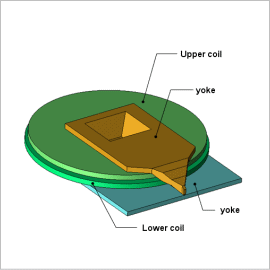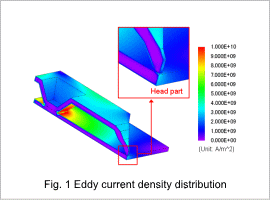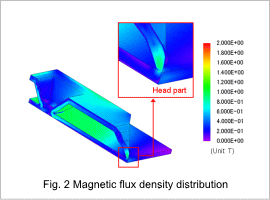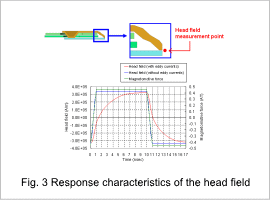*Please prepare a license ID and password for the license administrator.
*It is different from the service for JMAG WEB MEMBER (free membership). Please be careful.
Overview

Magnetic heads are devices that are used to record data on storage media, and are often found in hard disks. A magnetic head has both a recording head that writes data by magnetizing a round magnetic disk and a playing head that reads the data from the magnetic disk’s magnetization pattern. For the recording head, the vital thing is an evaluation of the recording head field’s responsiveness toward input electrical signals. This evaluation comes from a detailed evaluation of the magnetic flux density distribution around the head. To study these characteristics, the analysis needs to include the effect of eddy currents generate on the yoke.
In order to account for eddy current distribution that is produced in the fine part at the tip of the recording write head, a magnetic field analysis using the finite element method (FEM) is most effective.
This Application Note shows how to obtain the responsiveness of recording head field that is generated in the magnetic head.
In order to account for eddy current distribution that is produced in the fine part at the tip of the recording write head, a magnetic field analysis using the finite element method (FEM) is most effective.
This Application Note shows how to obtain the responsiveness of recording head field that is generated in the magnetic head.
Eddy Current Density Distribution / Magnetic Flux Density Distribution
Fig. 1 shows the eddy current distribution around the head, and fig. 4.2 shows the magnetic flux density distribution. As shown in the eddy current density distribution, eddy currents are generated on the surface of the yoke. This eddy current interrupts the flow of the magnetic flux, resulting in reduced responsiveness of the head field to the magnetomotive force.


Response Characteristics of the Recording Head Field

Fig 3 shows a graph of the response characteristics of the head field. The head field starts up more slowly than the magnetomotive force waveform. This is caused not by the coil inductance but also by the eddy currents on the yoke. When analyzing the response of the head field, the analysis must include the effects of eddy currents.


